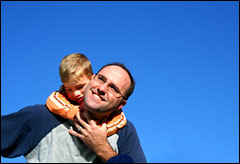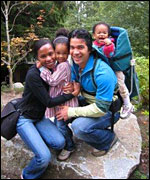Pop quiz time: plastic baby bottles are a) completely safe, or b) a risk to you, your baby, and every other living thing in the entire universe?
The answer lies somewhere in between — but you wouldn’t know it from most media reports. Over the last year, countless stories have sprung up citing research about the dangers of endocrine disruptor bisphenol A leaching from clear plastic baby bottles. But more often than not, those stories go on to trot out assurances from industry and government that BPA is perfectly safe.

Don’t hurry, don’t worry, and don’t forget to read the labels.
Photo: iStockphoto
Then there are phthalates, that handy family of chemicals that soften plastic and add fragrance to cosmetics — and also happen to be probable carcinogens and suspected endocrine disruptors. They’ve been found in, among other things, teething rings, dolls, rubber duckies, and baby lotion. They’re banned in Europe, and bans have been proposed in several U.S. states as well. But at low levels of exposure, says an industry rep, “there is no concern.”
So what’s a well-intentioned parent to do?
Alas, there are no clear answers. More science is needed, more regulation is needed, more industrial transparency is needed. In the meantime, it may be every parent for him- or herself. We asked a few environmental professionals — who also happen to be concerned parents — what they make of the whole mess, whether they’re freaked out by it, and what advice they’d give to other parents.
Tracey Woodruff, mother of three
Associate professor and director of the Program on Reproductive Health and the Environment, University of California-San Francisco
San Francisco, Calif.
Everybody has phthalates in their body. What’s concerning is that we don’t know what are the important sources — nobody can tell you what’s the biggest source, what’s a minor source. We should know what the chemicals are in our products, and this could be accomplished by labeling them. Phthalates aren’t adequately captured in the current regulatory structure. A more comprehensive policy would address these types of chemicals.

Tracey’s trio.
I’ve never seen a chemical turn out to be more benign than originally thought, though I would be interested to know of one. What typically happens is the more research, the more things they find the chemical does.
I just try to take whatever common-sense approach I can at home. It’s hard to do everything, but you can’t feel guilty. Why is it our responsibility when we don’t even know what chemicals are in the products we buy?
Tip: The best approach is a common-sense approach — don’t microwave in plastic, be careful about plastic wrap, buy consumer products that meet E.U. requirements, buy phthalate-free products, buy unscented products (phthalates are used for fragrance). And tell your representatives in the state and national legislature that you want companies to tell consumers all the ingredients that are in their products.
Marcelo Bonta, father of two
Director of the Center for Diversity and the Environment
Portland, Ore.

The Bonta bunch.
When reports like this come out, they confirm the suspicions that I already have. Ever since my girls were born, I’ve been trying to safeguard them from the ill effects of our environment. It’s a whole different ball game with children. My level of environmental awareness shot up exponentially when they came into my life. You want to be green not only because of your values, but now there are these little people in your lives who are much more vulnerable to toxins than you are and depend on you to make the right decision for them.
I know some baby items are going to be more dangerous than others. I started thinking, “Wow, we used plastic bottles, and now we have sippy cups that are plastic — should I be worried?” I started researching what to do, and then someone sent me a link about which companies use which plastic, and, fortunately, I discovered that the sippy cups we’re using are a better plastic. I sent the information to my friends and family.
When my wife and I grapple with making the difficult decisions that affect the health of our children, to ease the stress, she often says, “We grew up on plastic bottles and toys, and look how we came out.” And I say yeah, but maybe we could’ve come out better. Maybe I could’ve scored a few more points on the SATs.
Tip: Do some research. There’s a lot of good information on the internet. If there’s a specific product you like, but you’re not sure what’s in it, call the company.
Urvashi Rangan, mother of one
Senior scientist and policy analyst, Consumers Union
New York, N.Y.

Rangan and family.
What I tell people is, plastics leach what they’re made out of. Soft plastics leach phthalates, and hard plastics leach bisphenol A. We have a human safety limit that was set over a decade ago. Studies show that lower levels of exposure have an impact on animals. We still have a lack of human data, and we need more studies.
We can’t say based on the evidence we have that everybody needs to stop using everything that has [bisphenol A] in it. It comes down to personal choice around risk. If you’re risk-averse, you’re going to want to avoid things that could be a problem. Unfortunately, people need to make a value judgment.
Science is not a static thing — it’s going to progress over time. Right now, more research needs to be done. I think there are bigger things to worry about.
Tip: There’s a couple things you can do with [clear plastic] bottles you already have: if they start to get cloudy, get rid of them. Heat milk in a separate ceramic container or, if you microwave it, heat it in a cup and pour it into the bottle.
John Parks, father of two
Pacific island coastal specialist, NOAA
Honolulu, Hawaii

Parks and sons.
When it comes to plastics, we take more of a holistic approach. It’s not buying alternatives to plastics, it’s growing food, it’s using traditional cooking methods, it’s finding functional alternatives to plastic. Here, we use lauhala, woven pandanus leaves, for mats and plates. You could cut a coconut in half and make a mug, or cut bamboo and make it into cups. If you give the choice of a bright neon plastic plate versus a wooden plate, the neon will capture a kid’s attention for about five minutes, but the wooden plate will be interesting for two years. Kids gravitate toward materials that give them a sense of identity and connection to the place where they live. I’ve seen it.
It’s less of a discussion about plastics vs. non-plastics and more about the natural materials available to you. It’s about getting kids to have a sense of place, whether you’re in the city or the country. If it comes to it, if you’re in New York City, you could take your children to the park, teach them about the local flora, then buy products made from those materials. Then the health benefits of not ingesting plastic are collateral benefits — your consumer decisions are guided by a sense of place.
Tip: Don’t think, “I have to be green.” Think, “I belong to the land. I am green.” How to buy, what to buy all start from that sense.



